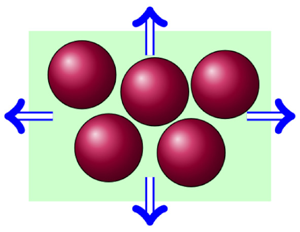Article contents
Non-isochoric stable granular models taking into account fluidisation by pore gas pressure
Published online by Cambridge University Press: 10 January 2024
Abstract

In this paper, we study non-isochoric models for mixtures of solid particles, at high volume concentration, and a gas. One of the motivations for this work concerns geophysics and more particularly the pyroclastic density currents, whose dense basal parts are precisely mixtures of pyroclasts and lithic fragments and air. They are extremely destructive phenomena, capable of devastating urbanised areas, and are known to propagate over long distances, even over almost flat topography. Fluidisation of these dense granular flows by pore gas pressure is one response that could explain this behaviour and must therefore be taken into account in the models. Starting from a solid–gas mixing model and invoking the compressibility of the gas through a law of state, we rewrite the conservation of mass equation of the gas phase into an equation of the pore gas pressure whose net effect is to reduce the friction between the particles. The momentum equation of the solid phase is completed by generic constitutive laws, specified as in Schaeffer et al. (J. Fluid Mech., vol. 874, 2019, pp. 926–951) by a yield function and a dilatancy function. Therefore, the divergence of the velocity field, which reflects the ability of the granular flow to expand or compress, depends on the volume fraction, pressure, strain rate and inertial number. In addition, we require the dilatancy function to describe the rate of volume change of the granular material near an isochoric equilibrium state, i.e. at constant volume. This property ensures that the volume fraction, which is the solution to the conservation of mass equation, is positive and finite at all times. We also require that the non-isochoric fluidised model be linearly stable and dissipate energy (over time). In this theoretical framework, we derive the dilatancy models corresponding to classical rheologies such as Drucker–Prager and  $\mu (I)$ (with or without expansion effects). The main result of this work is to show that it is possible to obtain non-isochoric and fluidised granular models satisfying all the properties necessary to correctly account for the physics of granular flows and which are well posed, at least linearly stable.
$\mu (I)$ (with or without expansion effects). The main result of this work is to show that it is possible to obtain non-isochoric and fluidised granular models satisfying all the properties necessary to correctly account for the physics of granular flows and which are well posed, at least linearly stable.
JFM classification
Information
- Type
- JFM Papers
- Information
- Copyright
- © The Author(s), 2024. Published by Cambridge University Press
References
- 2
- Cited by


